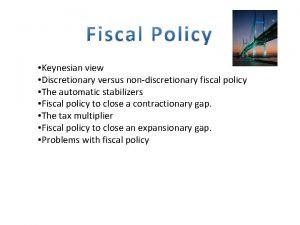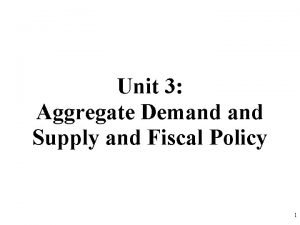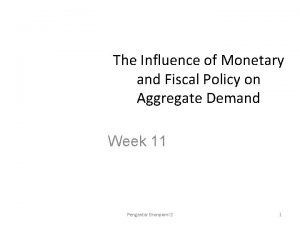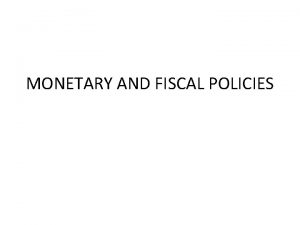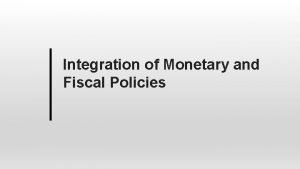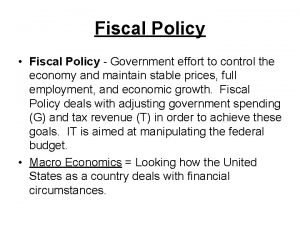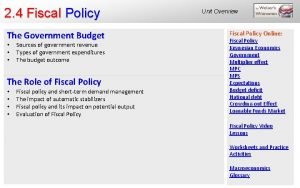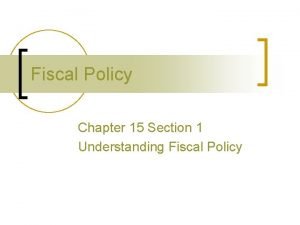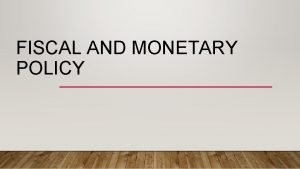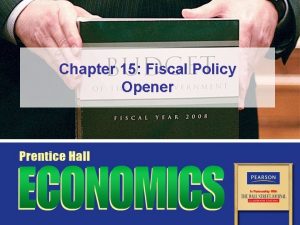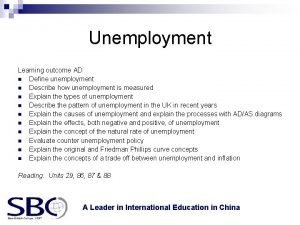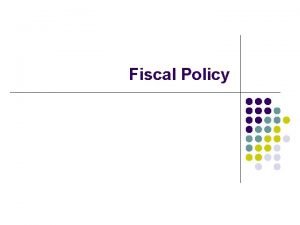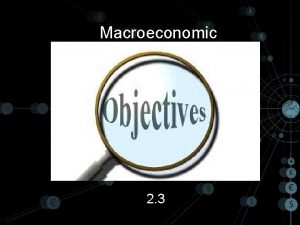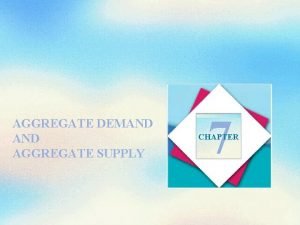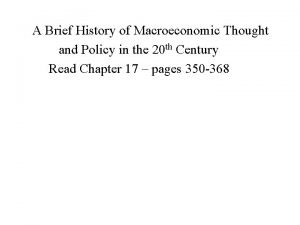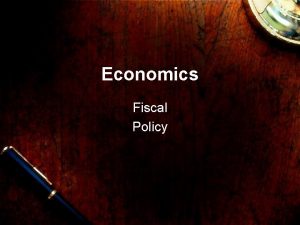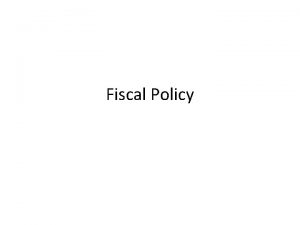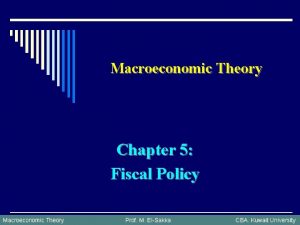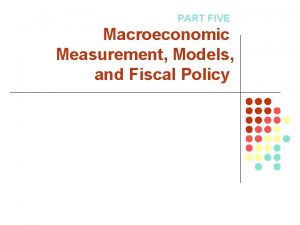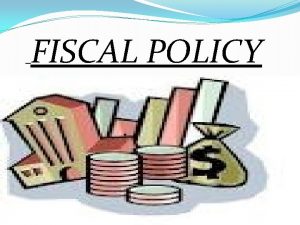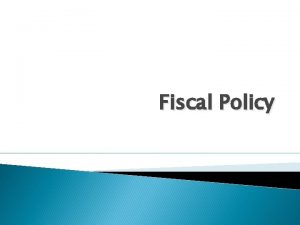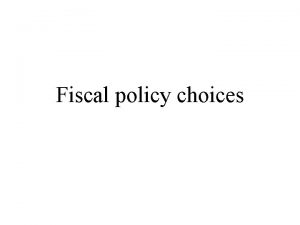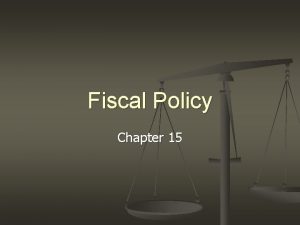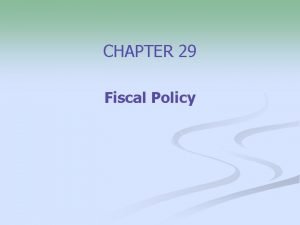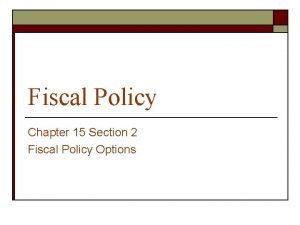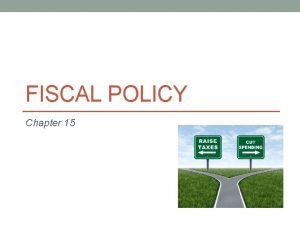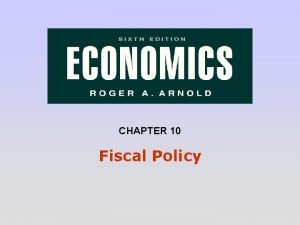PART 3 MACROECONOMIC MODELS AND FISCAL POLICY CHAPTER










































- Slides: 42

PART 3: MACROECONOMIC MODELS AND FISCAL POLICY CHAPTER 10 Aggregate Demand Aggregate Supply Slides prepared by Bruno Fullone, George Brown College © 2010 Mc. Graw-Hill Ryerson Limited 1

In This Chapter You Will Learn: • Learning Objective 10. 1: About aggregate demand (AD) and the factors that cause it to change • Learning Objective 10. 2: About aggregate supply (AS) and the factors that cause it to change • Learning Objective 10. 3: How AD and AS determine an economy’s equilibrium price level and level of real GDP • Learning Objective A 10. 1: (Appendix) How the aggregate demand curve relates to the aggregate expenditure model Chapter 10 2

10. 1 Aggregate Demand • Aggregate demand is a schedule or curve that shows the amounts of real output (real GDP) that buyers collectively desire to purchase at each possible price level LO 10. 1 3

Figure 10 -1 Aggregate Demand Price Level • Aggregate Quantity Demanded (Real GDP) and the Price Level are inversely related as follows: Figure 10 - 1 AD Real GDP LO 10. 1 4

Aggregate Demand • Slopes downward because of the following effects of a change in price level: 1. Real-balances Effect 2. Interest-rate Effect 3. Foreign Trade Effect Remember: these effects are caused by price level changes LO 10. 1 5

Changes in Aggregate Demand Figure 10 -2 Price level AD Can Increase shift RIGHT AD 1 AD 2 Real domestic output, GDP LO 10. 1 6

Changes in Aggregate Demand Figure 10 -2 Price level AD Can Decrease shift LEFT AD 3 AD 1 Real domestic output, GDP LO 10. 1 7

Determinants of Aggregate Demand • Changes in Consumer Spending – Consumer wealth – Consumer expectations – Household borrowing – Personal taxes LO 10. 1 8

Determinants of Aggregate Demand • Changes in Investment Spending – Interest Rates – Expected Returns • Expectations about future business conditions • Technology • Degree of excess capacity • Business taxes LO 10. 1 9

Determinants of Aggregate Demand • Changes in Government Spending • Changes in Net Export Spending – National Income Abroad – Exchange Rates LO 10. 1 10

10. 2 Aggregate Supply • Aggregate supply is a schedule or curve showing the relationship between the price level of output and the amount of real domestic output that firms in the economy produce • This relationship varies depending on three time horizons: • The immediate short run • The long run LO 10. 2 11

Aggregate Supply in the Immediate Short Run • In the immediate short run, both input prices and output prices are fixed • In the immediate short run, the aggregate supply curve is horizontal at an economy’s current price level • With output prices fixed, firms collectively supply the level of output that is demanded at those prices • As illustrated …. LO 10. 2 12

Figure 10 -3 Aggregate Supply in the Immediate Short Run Price Level ASISR Immediate-shortrun Aggregate Supply Qf 29 -13 Real Domestic Output, GDP

Aggregate Supply in the Short Run • The short run begins after the immediate short run ends • The short run is a period of time during which output prices are flexible but input prices are either totally fixed or highly inflexible. LO 10. 2 14

Aggregate Supply in the Short Run • The upward-sloping aggregate supply curve AS indicates a direct (or positive) relationship between the price level and the amount of real output that firms will offer for sale • The AS curve is relatively flat below the full -employment output • It is relatively steep beyond the fullemployment output • As illustrated … LO 10. 2 15

Figure 10 -4 Short-Run Aggregate Supply Curve Slope not constant: per unit production cost and firm capacity Price Level Aggregate Supply (Short Run) 0 29 -16 Qf Real Domestic Output, GDP

Price level Short-Run Aggregate Supply a 2 P 1 a 1 GDPf GDP 2 LO 10. 2 AS 1 an increase in price level increases profits & output, moving the economy from a 1 to a 2 Real domestic output 17

Short-Run Aggregate Supply Price level AS 1 a 1 P 3 a 3 GDPf a decrease in price level decreases profits & output, moving the economy from a 1 to a 3 Real domestic output LO 10. 2 18

Aggregate Supply in the Short Run • As the economy expands in the short run, per-unit production costs generally rise • The extent of the rise depends on where the economy is operating, relative to its Unless stated otherwise, capacity “aggregate supply” refers to – an economy below AS operating in the short run its fullemployment output has idle capital & labour little upward pressure on production costs – when the economy is operating beyond its full -employment output, most available resources are already employed per-unit production costs increase as economy LO 10. 2 expands 19

Aggregate Supply in the Long Run • For the economy as a whole, it is the time horizon over which all output and input prices are fully flexible • It begins after the short run ends • Price-level changes do not affect firms’ profits and thus they create no incentive for firms to alter their output • Illustrated … LO 10. 2 20

Figure 10 -5 Aggregate Supply in the Long Run Price Level ASLR Long-run Aggregate Supply Qf 29 -21 Real Domestic Output, GDP

Determinants of Short-Run Aggregate Supply 1. Change in input prices a. Domestic resource price b. Price of imported resources 2. Change in productivity 3. Change in legal-institutional environment a. Business taxes & subsidies b. Government regulation LO 10. 2 22

Decreases in (short-run) AS Figure 10 -6 AS 2 Price level AS 1 Real GDP LO 10. 2 23

Increases in (short-run) AS Figure 10 -6 AS 1 Price level AS 2 Real GDP LO 10. 2 24

10. 3 Equilibrium and Changes in Equilibrium • Equilibrium occurs at the price level that equalizes the amount of real output demanded & supplied Real Output Demanded (billions) Price Level (index number) Real Output Supplied (billions) $506 108 513 508 104 512 510 100 512 96 505 514 92 502 LO 10. 3 25

Figure 10 -7 The Equilibrium Price Level and Equilibrium Real GDP Price Level AS Equilibrium 100 92 a b AD 502 29 -26 510 514 Real Domestic Output, GDP (Billions of Dollars)

Increases in AD • For any initial increase in aggregate demand, the resulting increase in real output will be smaller the greater is the increase in the price level • Demand-pull inflation… LO 10. 3 27

Increases in AD Price level Figure 10 -8 P 2 Output does not AS increase all the way to GDP 1 because of inflation P 1 AD 2 GDPf GDP 2 Chapter 8 AD 1 Real GDP 1 28

Inflationary Gap • An inflationary gap is the amount by which equilibrium GDP exceeds potential GDP LO 10. 3 29

Decreases in AD: Recession and Cyclical Unemployment • Deflation, a decline in the price level, is a rarity in the Canadian economy • Real output takes the full brunt of the decline in AD because product prices are “sticky” in the short run – – – – fear of price wars menu costs wage contracts morale, effort, & productivity minimum wage menu costs fear of price wars LO 10. 3 30

Decreases in AD Figure 10 -9 Price level AS prices are sticky downwards P 1 AD 2 GDP 1 GDPf LO 10. 3 AD 1 Real GDP 31

Recessionary Gap • A recessionary is the amount by which equilibrium GDP falls short of potential GDP LO 10. 3 32

Decreases in AS: Cost-push Inflation • Effects of a leftward shift in AS are doubly bad – output decreases – price level increases LO 10. 3 33

Decreases in AS Figure 10 -10 AS 2 Price level AS 1 P 2 P 1 GDP 2 GDPf LO 10. 3 AD 1 Real GDP 34

Increases in AS: Full Employment with Price-Level Stability • Increases in AD should normally lead to inflation • Recently, productivity growth has shifted the long-run AS curve to the right LO 10. 3 35

Increases in AS Figure 10 -11 AS 1 Price level AS 2 P 3 P 2 P 1 AD 2 AD 1 GDP 1 GDP 2 GDP 3 LO 10. 3 Real GDP 36

The Last Word: Has the Impact of Oil Prices Diminished • Aggregate supply shocks • Cost push inflation • Oil prices affected core inflation prior to 1980 • Core inflation unaffected post 1980 – Energy efficiency – Composition of GDP – Bank of Canada vigilance

Chapter 10 Summary 10. 1 Aggregate Demand 10. 2 Aggregate Supply 10. 3 Equilibrium and Changes in Equilibrium Chapter 10 38

Appendix The Relationship of Aggregate Demand Curve to the Aggregate Expenditure Model

Deriving the AD Curve Aggregate Expenditures (billions of dollars) AE 1 (at P 1 ) AE 2 (at P 2 ) AE 3 (at P 3 ) As Price Levels Increases… Price Level 45° P 3 Real GDP Declines P 2 P 1 29 -40 AD GDP 1 GDP 2 GDP 3 Real Domestic Product, GDP

Deriving the AD Curve AE 2 (at P 1 ) Aggregate Expenditures AE 1 (at P 1 ) Increase in Aggregate Expenditures Price Level 45° Increase in Aggregate Demand P 1 AD 2 AD 1 29 -41 GDP 2 Real Domestic Product, GDP

Deriving the AD Curve AE 2 (at P 1 ) Aggregate Expenditures AE 1 (at P 1 ) The Shift in the Aggregate Demand Curve is a Multiple of the initial Change in Aggregate Expenditures Price Level 45° P 1 AD 2 AD 1 29 -42 GDP 1 GDP 2 Real Domestic Product, GDP
 Macroeconomic policy debates
Macroeconomic policy debates Perlukah pemerintah menyeimbangkan anggaran belanjanya
Perlukah pemerintah menyeimbangkan anggaran belanjanya Six debates over macroeconomic policy
Six debates over macroeconomic policy Five debates over macroeconomic policy
Five debates over macroeconomic policy Five debates over macroeconomic policy
Five debates over macroeconomic policy Contractory monetary policy
Contractory monetary policy Aggregate supply shifters
Aggregate supply shifters Tax multiplier formula
Tax multiplier formula Define non-discretionary fiscal policy
Define non-discretionary fiscal policy Unit 3 aggregate demand aggregate supply and fiscal policy
Unit 3 aggregate demand aggregate supply and fiscal policy What is inflation
What is inflation Example fiscal policy
Example fiscal policy Government expenditure multiplier formula
Government expenditure multiplier formula Components of fiscal policy
Components of fiscal policy Crowding out effect of fiscal policy
Crowding out effect of fiscal policy What is liquidity ratio in banking
What is liquidity ratio in banking Fiscal policy
Fiscal policy Accelerator effect economics
Accelerator effect economics Fiscal demand side policy
Fiscal demand side policy Fiscal policy definition
Fiscal policy definition Types of fiscal policy
Types of fiscal policy Instruments of fiscal policy
Instruments of fiscal policy Crowding out definition ap macro
Crowding out definition ap macro Demand side fiscal policy definition
Demand side fiscal policy definition What is expansionary monetary policy
What is expansionary monetary policy Crowding out effect of fiscal policy
Crowding out effect of fiscal policy Example of expansionary fiscal policy
Example of expansionary fiscal policy Fiscal policy
Fiscal policy Goals of fiscal policy
Goals of fiscal policy Fiscal vs monetary policy
Fiscal vs monetary policy Goals of fiscal policy
Goals of fiscal policy Fiscal policy
Fiscal policy Classical unemployment
Classical unemployment Fiscal policy
Fiscal policy Conclusion of monetary policy
Conclusion of monetary policy Fiscal policy definition
Fiscal policy definition Fiscal policy
Fiscal policy Macroeconomic and industry analysis
Macroeconomic and industry analysis Unemployment
Unemployment Macroeconomic equilibrium occurs:
Macroeconomic equilibrium occurs: Macroeconomics deals with?
Macroeconomics deals with? History of macroeconomic thought
History of macroeconomic thought A macroeconomic theory of the open economy
A macroeconomic theory of the open economy








